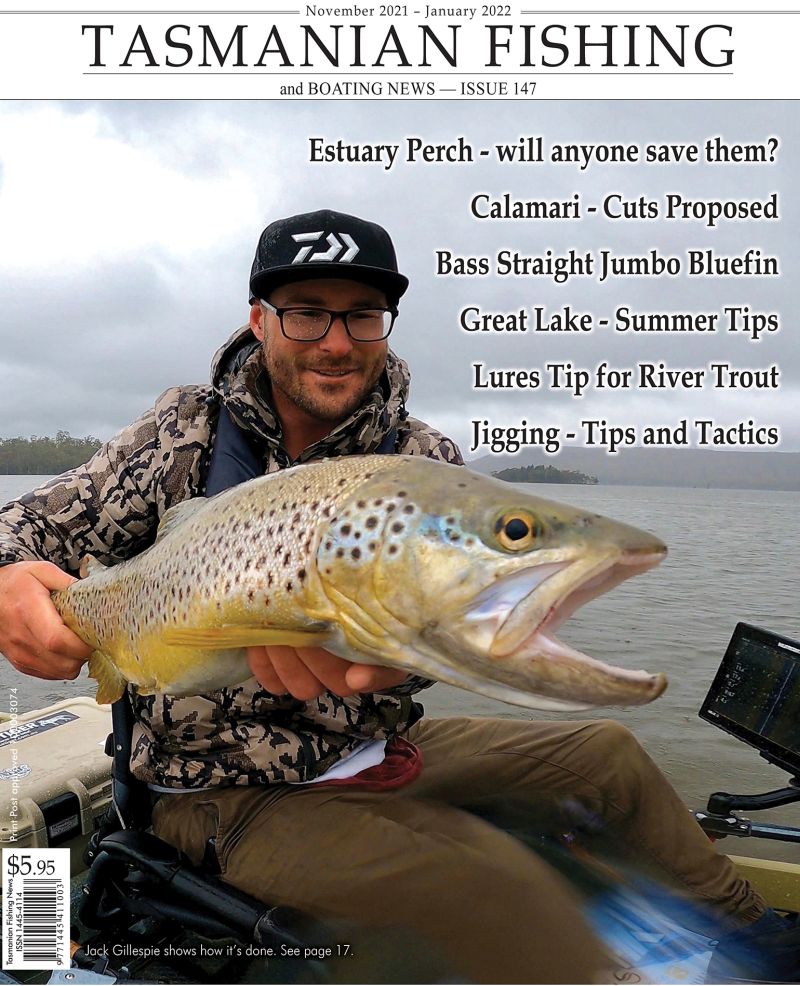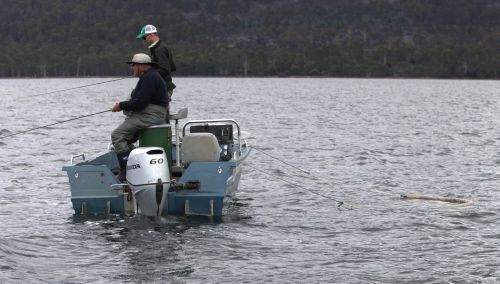BRUMBYS CREEK
Simon Little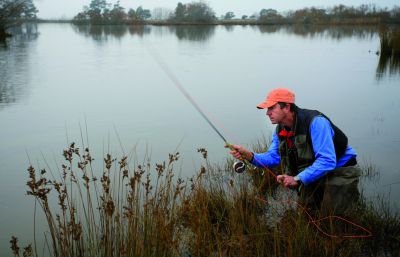 Brumbys Creek is one of the best known and consistently fished trout rivers in Tasmania and this is not without good reason. On its day Brumbys can be surface busting fun in the sun and yet as with everything else in fishing, things can go horribly wrong.
Brumbys Creek is one of the best known and consistently fished trout rivers in Tasmania and this is not without good reason. On its day Brumbys can be surface busting fun in the sun and yet as with everything else in fishing, things can go horribly wrong.The lowland fishery is located only 30 minutes short drive south of Launceston making it an easy morning or afternoon trip for anyone living in town. It lends itself well to almost all fishing styles, ranging from bait fishing with unweighted worms to bottom fishing powerbait, casting big hard bodied lures to wet and dry flies and my favourite, soft plastics. The river winds through low farm lands and is mostly comprised of three weirs and in/outflow water. Levels are controlled throughout the year by the hydro station and the quality of the fishing can be highly dependent on the volume of water moving through the system.
Brumbys Creek can be fished well right from the start of the season all the way through to the last day but in order to make the most of your time spent at the water you need to be able to work out where the fish will be and what they will be eating. With summer in full swing the weather will be warming up and for those who can get onto the trout the fishing should heat up with it.
Early on in the season when the weather is cold, rainy and overcast, the water level is high and clarity is almost a non-event, fish at Brumbys can be taken from backwaters and flooded banks using many various methods. As the water shallows out, drains away and clears up the fish’s feeding habits and locations will change. Changing your approach to suit the conditions will drastically enhance the results you can obtain.
LOCATIONS (click on this map to download the Hi-Res PDF of the map)
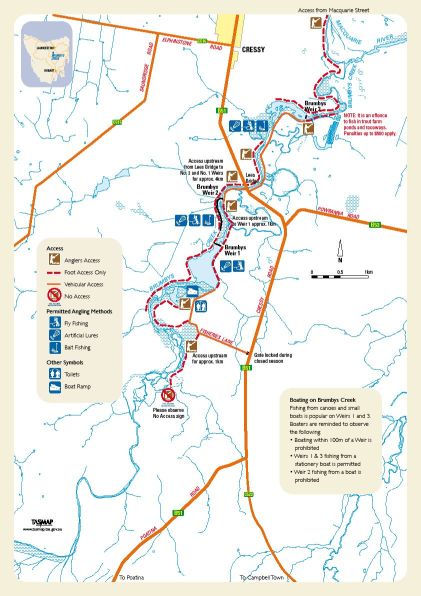
Above the first (top) weir
Above the first weir Brumbys Creek is a wide shallow pondage riddled with deep channels, shallow banks and plenty of weed and wood structure. It is often underestimated as a fishery and underutilized by anglers due to limited boating access. Fishing from a boat is allowed but only while the boat is stationary. Access to the pondage is by Fisheries Lane, a dirt road that leads to the right of the main road approx two minutes drive past Lees Bridge. There is a gate as you turn off the bitumen that should always be closed once you are through it. Launching facilities are lacking and because of this and the nature of the pondage small tinnies, inflatables and kayaks are ideal.
Spinning along the edges of current lines and dry fly fishing the eastern shore above the weir seem to be the major highlights in a boat. There is also much to be said about working soft plastics around the protruding structure. On very still mornings I have found that some of the larger fish will swipe at a surface lure worked in close around the edges of anything that shows above the water.
Although fishing from a boat or kayak can be very advantageous, land based anglers are far more common and there are plenty of places where great fish can be caught from the banks. For me the highlight this summer will be polaroiding the shallow edge along the recently cleared banks adjacent to the dirt road that leads up from the weir along the eastern shore. We have snared several good fish along this section already this year and I’m sure there are plenty of bigger and better fish to be found.
Water temperature in Brumbys Creek does not vary a great deal throughout the year though water level can fluctuate daily. In summer, rain will dirty up the water slightly but it doesn’t take a long time to clear up again. Wind features highly in the factors affecting water clarity and particularly it will cover the surface of the upper pondage with a patchwork of leaf congregations. Trout can often be found lurking around and under these temporary tarpaulins and once the wind dissipates, the leaves form together to show clear current lines and food flow patterns. It can be a road map to success.
Despite being more reputed as the premier fly fishing area of Brumbys, the first pondage can be fished with lures and baits until weed growth is stimulated by the warmer weather and the accessible water becomes more limited. Bait fishing is prohibited above the first weir.
Above the second weir
Below the first weir there is a wide flat expanse of shallow water. The bottom is muddy and weedy and fishing with lures is mostly impractical. Ultra-light soft plastics and surface lures can be worked to some success but without waders it is best left alone.
The outflow of this water is over a shallow weed bed which drops off into a long deep channel flanked by a sharp edge on the east and wide weedy flats on the west. The eastern edge directly below the weir has a small outcrop of land that is practically permanent year round. The outcrop creates a deep harbour surrounded by reed growth. In periods of short hard rainfall, in particular during summer, the south and eastern edges of this harbour will flood temporarily and there is almost always a good brown trout or two cruising lazily around in the shallows. It is well worth while approaching this area with some degree of stealth and scanning the shallows for fish.
The fast waters directly below all three weirs are often considered as hotspots for lure casting but don’t be tricked into thinking that these are the only good places to flick a hard body or soft plastic. Downstream of top weir, where the water runs off the shallow weed bed into the deep channel, large browns will congregate and smash any small fish, insects and food that come within a bulls roar of them. On clear, bright, sunny days the entire channel holds big and small fish all the way down to the second weir. Targeting these fish can be difficult but it is still much easier than trying to find them in the shallows when the sun’s out and about. Most strikes will come from down around the bottom of the western edge drop off. You can clearly see the drop off on the western side of the channel. It is almost essential that the lure is working down deep along the bottom here and a good tactic can be to cast just over the edge to the flats and work it down the face of the drop off. Access along this stretch of river is limited by trees and blackberries but there are still plenty of places between them where you can fish comfortably.
The water widens as it approaches the second weir and although I have heard of many people having success directly above it, I myself have not experienced any exceptional fishing there. The road to the right directly after Lees Bridge leads all the way up to the second weir and from there Anglers Access signs and stiles mark the way upstream.
I might mention also that for most of the first and second weirs, waders are an excellent choice. The growth around the edges can get pretty excessive and a lot of the banks are too soft and mushy to walk in shoes. Fishing from a boat is prohibited between the first and second weir.
Above the third weir
The fast water below the second weir is a productive place to fish lures and is easily accessed from the road. The cleared banks make it very comfortable fishing almost all the way down to the bottom weir but the last 500 meters or so is pretty hard to get to.
Most fish in this stretch of the river seem to be smaller than the other sections but the ease of access makes it a popular choice for a lot of people. Although I very rarely fish baits for trout, this area of Brumbys is one that can be well worth a lazy day. Bait fishing is generally most productive in the poundages above the weirs but there are spots all the way along that can yield the goods. The slower sections of river, especially if they are downstream of a run-off, can be fished really effectively with the age old worm on a hook method.
One of my friends, who frequents Brumbys on a more than regular basis, has become quite proficient at producing fish from the start of the trees along the eastern shore downstream of Lees Bridge. The flow breaks up in a few places below Lees Bridge and there are some marvellous backwaters and offshoots of water on the western shore but most of these are difficult to access. There is a distinct joining of two flows around 20 metres along the tree lined bank and he fishes the confluence with a running sinker rig and worms. He also uses a secret ingredient on the worms but refuses to tell me the recipe.
Much of the river below the second weir flows over shallow weed beds and can be difficult to fish with a diving lure or heavy jig head. Covering the more defined gutters and drop offs is the best way to extract a trout. There is a lot of scope for fly fishing along this section but it is generally unremarkable compared to the uppermost pondage.
Access to this section of river is by foot on the western shore and by the road directly after Lees Bridge on the eastern shore. Fishing from a stationary boat is permitted in the pondage and it can be a valuable asset for covering some of the less fished water.
Below the third weir
Brumbys Creek flows into the Macquarie River downstream of the third weir and the banks are easily fished for a long stretch. The road leading east after Lees Bridge leads all the way to the weir itself and access from there on is by foot. The fast water directly below the weir is productive and escaped rainbow trout from the commercial farm often turn up on lures. The river between the third weir and Macquarie River is fairly generic and plain. It consists of one main channel with few gutters and some typical weed growth.
Although it does not have the appealing looks of the upstream pondages and channels it can really fire up and generate a great days fishing. It can be fished well with lure, fly and bait. Fishing from a boat is prohibited.
METHODS
Fly fishing
Because Brumbys Creek is maintained at a reasonably even level and water temperature throughout the year, hatches are not as intense as many other lowland fisheries though they do occur over a long period of time. Fishing can fire up very early in the season and carry through right to the last days before close.
During warm, humid weather, red-spinner duns during the day and adult spinners at dusk really stir the fish up and the best hatches will occur late spring and early summer. Some more mild hatches will continue through January and February and probably will re-occur right at the end of the season.
Tailing fish appear from the beginning of August and usually continue right through into January. Most people will find tailers in the top pondage during the early morning or late afternoon and sometimes throughout the day when the weather is more overcast. Once summer is in full swing and when the wind is dead still, sunrise trips can lead to some excellent catches of smutting fish along the edges of current lines.
Best dry fly fishing at Brumbys occurs on warm nights just as the sun dips below the horizon when fish will rise to a huge variety of insects. Large dry flies seem to excite more fish in the last minutes of light and smaller flies are the ticket during the day.
Lure fishing
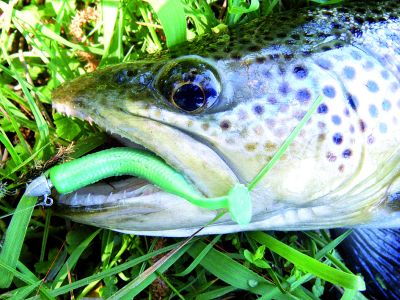
I think Brumbys is under-rated as a lure fishing water. We have been able to consistently produce not only good numbers but also good size fish throughout the season on soft plastics but the trick is to know the when and where on the day.
On a bright sunny day when the water is fairly clear and the wind is fairly still, lure fishing is best along the deep channel that runs between the first and second weirs. The big browns will often hold up in the deepest, darkest pockets of water and will only strike at something that comes close past them. Although slow, if you do get a fish doing this it will most often be a solid catch and many of ours have exceeded 4lbs.
After a heavy rain when there is likely to be a lot of food flowing down the river, anywhere from the bottom of the first weir down to the confluence with the Macquarie can yield results. Targeting run-offs and recently submerged banks is a key element.
If there has been a light shower and especially during one, the fishing along the eastern shore above the first weir fires up and a lot of bigger fish show up on lures. Fishing in the rain in summer can be a fantastic way to snag lots of fish and/or big fish on lures and seizing the right moment can provide spectacular sport. Brumbys fishes particularly well in less than favourable weather. For soft plastics and hard body fisherman alike, putting up with a drop of rain is well worth the duress.
If you have a boat, early morning and late afternoon trips are excellent for retrieving vibes along current lines in the top pondage. Big numbers can be taken on MF40s and blades with natural colours being most effective. Although the fishing can be fast and furious, I haven’t caught many really big fish using this method. The average is probably around 1½ lb.
In terms of size, colour and style, for soft plastics, a paddle tail in the fast water and a minnow style in the slow water. When the water is clear brown and tan colours work well and when it is murky, especially after a heavy rain or intense wind then bright green and purple have been my colours of choice. If I use hard bodied lures I opt for bibbed minnows and cobras for the fast water and vibes/blades/MF40s for the pondages.
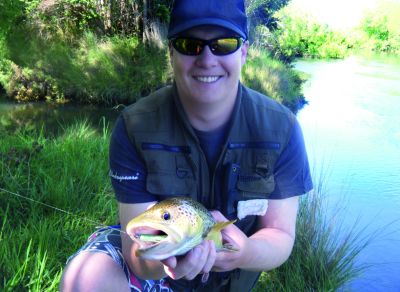
This is really the only water that I fish where I will use this combination of lures and soft plastics and it’s just a developed pattern from hours of trial and error. For specifically targeting big fish the 3.5 paddle tails are a great option matched with a 1/16 oz jig head with a #1 hook. On the hard bodies I will go for around a 10 cm floating lure that dives fairly quickly and one that I can maintain at the right depth without surfacing or pulling bottom. Most often I will only use the larger soft plastics and bibbed lures in the current lines of the upper pondage or in the deep water between weirs one and two.
In terms of gear, a long rod is handy for the pondages as it allows for a good long cast to avoid getting close and spooking fish. For the more overgrown sections and where casting accuracy is required a shorter rod will make life a lot easier.
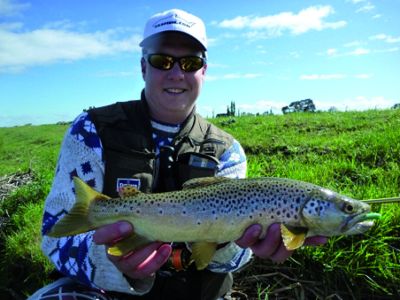 Most of Brumbys Creek contains very little real snag structure and I find that light lines and drags are no trouble at all. It gives the fish plenty of room to move without pulling out the hooks or spitting them in the air and does a little less damage as you bring them back to the boat.
Most of Brumbys Creek contains very little real snag structure and I find that light lines and drags are no trouble at all. It gives the fish plenty of room to move without pulling out the hooks or spitting them in the air and does a little less damage as you bring them back to the boat. Bait fishing
Bait fishing is prohibited above the first weir in Brumbys Creek but the rest of the river contains plenty of other places where they can be fished to great success. I will admit that there is actually some small art to consistently producing good fish on baits at Brumbys. Some people have it sussed out and regularly come home with a good feed or photos and some people spend hours watching a motionless rod tip.
The most successful method I have found is to cast an unweighted worm upstream and drift it along edges or structure. In this way I can cover a lot of water and bring the game to the fish rather than sit and wait. For those that prefer to set a rod and watch for the bite, worms and wattle grubs fished under a float in the pondages can find cruising fish.
The other method a lot of people do well with is to sit a sinker on the bottom in eddies and slower sections where two flows meet. Anywhere downstream of Lees Bridge can turn up a fish depending on prevailing conditions and experience will tell you where the fish might be lurking. Brumbys Creek can be a lot of fun and with experience and learning it can become a great place to consistently produce solid fish from. I have a program for the computer which I log all my fishing trip data into and our average for last season was very impressive compared with a lot of the nearby rivers. Some fish have exceeded 5 lbs and there are plenty more in there still. As the summer comes on and the weather warms up go get cracking and catch a fish at Brumbys. You might be surprised.
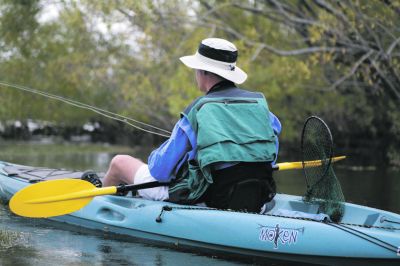
Simon Little

